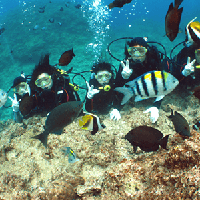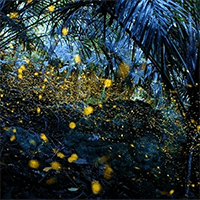Things to do in Kinkakuji/Kitano-tenmangu Area
Tenmangu Kitano Sugawara public which has been popular as a God of learning has been enshrined, the examination and employment activities, is popular as a place to pass pray as there is a divine favor for each test. The precinct, a number of cattle of the image, or better the head and stroking the cattle, has been with the disease is cured. In the spring, it is the precincts bloom is also of plum blossoms 1500, show us a view of the masterpiece. Ji historic was built in the Kamakura period is also referred to as the Golden Pavilion from Kinkaku of luxurious of the three-layer structure, high popularity from its luxurious appearance, has been known to Kyoto as a representative tourist spot. Arashiyama and is visited easy to spot because to go by bus from Gion. In this area, dressing and tea ceremony experiences, such as Me Yuzen, traditional crafts There is a wealth of activities that can be experience.
- Age 1~Age 70
- Over 6 hours on the day
- 08:40 / 09:50
Board and disembark at the meeting point08:40▼Nihonbashi Station, Exit 2 (Namba-Shinsaibashi area)09:50▼Kyoto Station, Hachijo Exit (in front of 7-Eleven)10:30▼Kinkaku-ji Temple (approx. 40 mins)Visiting fees are at the customer's expense.12:00▼Kiyomizu-dera Temple area (individuals will visit, stroll freely, and have lunch on their own / approx. 3.5 hours)15:30▼Fushimi Inari Taisha Shrine (approx. 70 mins)17:00▼After a fun end to the day's itinerary, start heading back.19:00▼Shinsaibashi, Dotonbori area (free stroll / approx. 1 hour)
- Age 4~Age 100
- 1~2 hours
- 10:00 / 11:00 / 12:00 / 13:00 / 14:00 / 15:00 / 16:00
In this plan, you can choose your favorite from M course, T-shirt (90 – XXXL), tote bag (medium size), and the whole process of Japanese traditional craft "Roketsu dyeing" "Dyeing and drying from drawing" You will experience "until". No need for painting, even children are OK! !! A locust dyeing craftsman will carefully guide you. Choose from many sketches and combine them. Also, the original design is OK. Trace the sketch using a brush with wax, then put on boots, apron, and gloves and dye it yourself. After dyeing, remove the wax you drew and you're done. The part drawn with wax remains white as the original fabric without being dyed, and you can easily create simple and deep works dyed with wax, such as shades due to the thickness of the wax and crack patterns due to wax cracks. The work is completed in about 90 to 120 minutes and you can take it home on the day. ~ Flow of the day ~ ① There are many sketches available, so you can choose your favorite sketch from them. The original design is also OK ② Once the sketch is decided, trace the sketch using a brush with wax. Draw a rough sketch with the heated wax included in the brush. ③ Dye the cotton cloth with the sketch drawn with wax in the dye. Please enjoy the dyeing experience by yourself. ④ Soaping work: Put the dyed cotton cloth in a kettle with boiling water and remove only the wax from the cloth. ⑤ Wash the cotton cloth from which the wax has been removed, dehydrate it with a dehydrator, and then dry it. ⑥ You can take home the finished work on the day. Please take home your precious memories in Kyoto.
できるかなぁ〜と半信半疑で考えた下絵が、結構良い風合いで出来上がったので満足でした。結構作業が大変かと思いましたが、ご主人さんとお母さんのご協力もあり、お手軽に体験させてもらうことができました。今度は友人に紹介しようと思います。
- Age 4~Age 100
- 1~2 hours
- 10:00 / 11:00 / 12:00 / 13:00 / 14:00 / 15:00 / 16:00
In this plan, you can choose your favorite from M course, tenugui (35cmx98cm), tapestry (45cm x 90cm), goodwill (45cm x 90cm), and the whole process of Japanese traditional craft "Rouketsu dyeing" "Drawing a picture" From dyeing to drying ”. No need for painting, even children are OK! !! A locust dyeing craftsman will carefully guide you. Choose from many sketches and combine them. Also, the original design is OK. Trace the sketch using a brush with wax, then put on boots, apron, and gloves and dye it yourself. After dyeing, remove the wax you drew and you're done. The part drawn with wax remains white as the original fabric without being dyed, and you can easily create simple and deep works dyed with wax, such as shades due to the thickness of the wax and crack patterns due to wax cracks. The work is completed in about 90 to 120 minutes and you can take it home on the day. ~ Flow of the day ~ ① There are many sketches available, so you can choose your favorite sketch from them. The original design is also OK ② Once the sketch is decided, trace the sketch using a brush with wax. Draw a rough sketch with the heated wax included in the brush. ③ Dye the cotton cloth with the sketch drawn with wax in the dye. Please enjoy the dyeing experience by yourself. ④ Soaping work: Put the dyed cotton cloth in a kettle with boiling water and remove only the wax from the cloth. ⑤ Wash the cotton cloth from which the wax has been removed, dehydrate it with a dehydrator, and then dry it. ⑥ You can take home the finished work on the day. Please take home your precious memories in Kyoto.
- Age 4~Age 100
- 1~2 hours
- 10:00 / 11:00 / 12:00 / 13:00 / 14:00 / 15:00 / 16:00
In this plan, you can choose your favorite from S course, square size (45cm x 45cm, place mat (32cm x 45cm), tote bag (S size)), and the whole process of Japanese traditional craft "Rocket dyeing" "Draw a picture" You will experience "From things to dyeing and drying". No need for painting. Children are OK! The placemat dyeing craftsman will carefully guide you. Choose from many sketches and combine them. Also, the original design is OK. After tracing the sketch, put on boots, an apron, and gloves and dye it by yourself. After dyeing, remove the drawn wax. You can easily make a simple and deep work dyed with a placemat such as a crack pattern. The work is completed in about 90 to 120 minutes and you can take it home on the day. You can choose your favorite sketch. You can also use the original design. ② Once you have decided on the sketch, trace the sketch with a brush with a wax. ③ Draw the sketch with the heated and melted wax in the brush. ③ Draw the sketch with the wax. Dye the drawn cotton fabric by immersing it in dye. Enjoy the dyeing experience by yourself. ④ Soaping work: Put the dyed cotton fabric in a kettle boiled in boiling water and remove only the wax of the fabric. ⑤ Wash the cotton cloth from which the wax has been removed, dehydrate it with a dehydrator, and then dry it. ⑥ You can take the finished work home on the day. Please bring back your precious memories in Kyoto.
They taught us patiently and diligently so it’s really recommended for beginners too. There are many design that we can chose from, you can be as creative as you can.
- Age 13~Age 80
- 1~2 hours
- 10:00 / 11:00 / 12:00 / 13:00 / 14:00 / 15:00 / 16:00
■Brass flat 4mm width 4900 yen■Silver flat 3mm width 4900 yenWe recommend a width of about 3mm for soldering at first. If you would like a wider ring, please contact us. ◇Free options・Select surface texture (roughened, polished, mirror polished)・Select size (free up to size 14)◇Paid options・Select size Silver〈15-19 +¥500〉〈20-24 +¥700〉〈25 and over +¥1,000〉・Engraving +¥500 *Even if you have prepaid online, you can pay the difference at the store on the day, so please consider it after seeing it in person! (All prices include tax.) 〇 Women can also make matching items together ♪ 〇 Couples can have anniversaries engraved, making it a great way to commemorate milestones ♪ 〇 This is a space where you can experience the world of engraving and the joy of metalworking through the production of rings, with shiny mirror finishes and the ancient surface finish called tsuchime. 〇 A craftsman will support you until the final finishing, so even those who are not good at delicate work can rest assured. 〇 Since it is a private rental for one group, there are sufficient measures against COVID-19 infection for those with children. ~Experience flow~ [1] First, measure the size of your finger. [2] Customers can hit the surface with a hammer, polish it, and add texture to their preference. [3] Bend the ring. [4] Solder and polish it to finish! ~Access~ ○ 5 minutes walk from Kyoto City Bus "Daitokuji-mae" Next to Cafe Sarasa Nishijin ○ 15 minutes walk from Subway Kuramaguchi Station ○ There are many paid parking lots in the area
it was a pleasant and fun experience making the rings!! the instructor was very patient and helpful, so even if you have no experience, it was still straightforward and relatively easy to make a cool ring. would highly recommend it for friends and couples when visiting the area if you have a some downtime
- Age 1~Age 70
- 5~6 hours
- 07:30
07:30-08:30: Pick-up/drop-off/transfer to hotel/private inn Hotels/private inns within the Osaka Loop Line 10:00 ▼ Kiyomizu-dera area (individual worship, free stroll, free lunch/approximately 3 hours) Recommended sightseeing course Course 1: Kiyomizu-dera (customer pays admission fee) - Ni-san-nen-zaka - Ishibe-koji - Gion·Hanami-koji-dori - Yasaka Shrine You can visit your favorite spots according to your stamina and time~Course 2: Kimono experience (Customers who are interested can wear a kimono and enjoy the old townscape and touring Kiyomizu-dera Temple. Let's take pictures of the wonderful moment.) (There are many kimono shops near Kiyomizu-dera Temple and Fushimi Inari Taisha Shrine. We recommend renting a kimono at a shop at Kiyomizu-dera Temple and returning it at a shop at Fushimi Inari Taisha Shrine. The fee is at the customer's expense.) 13:30 ▼ Fushimi Inari Taisha Shrine (individual visit and free stroll / about 70 minutes) 16:00 ▼ Nara Park (individual visit and free stroll / about 1.5 hours) "Deer and autumn leaves" interweave "Nara Park" The contrast between the autumn leaves and evergreen trees is vivid Recommended tourist spot [Todaiji Temple] (Admission fee is at the customer's expense.) Todaiji Temple was built during the Nara period. Nara is popular with tourists and once served as the capital of Japan. It is registered as a World Heritage Site as one of the "Cultural Monuments of Ancient Nara" by UNESCO. Todaiji Temple has eight national treasure buildings, 14 buildings with 24 national treasure Buddha statues, and nine other national treasures including paintings and books. The famous Great Buddha, the Great South Gate, the Kongorikishi statues, and the Hokkedo Hall, as well as the Buddha statues enshrined within, are all national treasures. There are very few places in Japan where you can see so many national treasures at once. Admission fee: Todaiji Temple Great Buddha Hall: 600 yen for adults (junior high school students and above), 300 yen for elementary school students; Great Buddha Hall and Todaiji Museum: 1000 yen for adults (junior high school students and above), 400 yen for elementary school students 17:30▼After a fun day of sightseeing, we start to head back. 18:30Shinsaibashi, Dotonbori area (Guests on the course that takes you to your hotel or guesthouse should wait for the shuttle bus. When the shuttle bus arrives, we will take you back to your hotel or guesthouse and the tour will end.)
- Age 1~Age 70
- 5~6 hours
- 08:40 / 09:50
Boarding and disembarking at the meeting point 08:40▼Nihonbashi Station Exit 2 (Namba-Shinsaibashi area) 09:50▼Kyoto Station Hachijo Exit (in front of 7-Eleven) 10:00▼Kiyomizu-dera area (individuals will visit the temple, stroll around freely, and have lunch at their leisure / approx. 3 hours) Recommended sightseeing course Course 1: Kiyomizu-dera Temple (customers are responsible for admission fees) - Ni-Sannenzaka - Ishibekoji - Gion·Hanamikoji-dori - Yasaka Shrine You can visit your favorite spots according to your stamina and time~Course 2: Kimono experience (Customers who are interested can wear a kimono and enjoy the old townscape and touring Kiyomizu-dera Temple. Let's take pictures of the wonderful moment.) (There are many kimono shops near Kiyomizu-dera Temple and Fushimi Inari Taisha Shrine. We recommend renting a kimono at a shop at Kiyomizu-dera Temple and returning it at a shop at Fushimi Inari Taisha Shrine. The fee is at the customer's expense.) 13:30 ▼ Fushimi Inari Taisha Shrine (individual visit and free stroll / about 70 minutes) 16:00 ▼ Nara Park (individual visit and free stroll / about 1.5 hours) "Deer and autumn leaves" interweave "Nara Park" The contrast between the autumn leaves and evergreen trees is vivid Recommended tourist spot [Todaiji Temple] (Admission fee is at the customer's expense.) Todaiji Temple was built during the Nara period. Nara is popular with tourists and once served as the capital of Japan. It is registered as a World Heritage Site as one of the "Cultural Monuments of Ancient Nara" by UNESCO. Todaiji Temple is home to eight national treasure buildings, 14 locations with 24 national treasure Buddha statues, and nine other national treasures including paintings and books. Famous sights such as the Great Buddha, the Great South Gate, and the Kongorikishi standing statues are all national treasures, as are the Hokkedo temple buildings and the Buddha statues enshrined within. There are very few places in Japan where you can see so many national treasures at once. Admission fees: Todaiji Temple Great Buddha Hall: Adults (junior high school students and above) 600 yen, elementary school students 300 yen; Great Buddha Hall and Todaiji Museum: Adults (junior high school students and above) 1000 yen, elementary school students 400 yen 17:30▼After a fun day of sightseeing, we start heading back. 18:30 Shinsaibashi, Dotonbori area (free time/approximately 1 hour)
- Age 4~Age 99
- Within 1 hour
- 11:45 / 13:00 / 14:15 / 15:30 / 16:45
Learn the spirit, history and manners of the tea ceremony and experience the tea ceremony. The feature is that customers can actually experience the tea ceremony as well as watch the show in front of the spot. Includes two dried sweets and light brown clothes. After the tea ceremony experience, you can also experience making matcha yourself.
コロナウイルスの影響で大変な中、1人でも受け入れてくださり色々丁寧に教えてくださいました。苦い抹茶しか飲んだことしかありませんでしたが、甘くてとても美味しかったです。身近に取り入れられるように、抹茶や煎茶の種類なども、機会があれば勉強してみようと思いました。
- Age 7~Age 80
- 1~2 hours
- 10:00 / 11:00 / 12:00 / 13:00 / 14:00 / 15:00 / 16:00
*Many free options we are proud of* Easy-to-understand pricing for unlimited processing within a set time! ・Various surface texture processing such as hammering, roughening, design hammering, and stone processing ・Twist processing, which is often charged at other stores (some stores charge an extra 3,000 yen), is also free. *2 Depending on the thickness and design, some processing cannot be done. *What are the paid options? *・Engraving of alphanumeric characters +500 yen・For larger sizes with wrist sizes of 18cm to 20cm, +500 yen, 20cm to 21cm +1000 yen. We can make a bangle that fits perfectly to you! [Brass] ■3mm 3500 yen ■4.5mm 4000 yen ■5.5mm 4500 yen ■7mm 4900 yen ■9mm 5500 yen ■Sharp bangle "Thin" 3900 yen "Thick" 4400 yen [Two-color bangle brass + copper] □3mm square wire 3500 yen [Silver 950] □Square wire 2mm 7900 yen ~ 8900 yen □Square wire 2.5mm 8900 yen ~ 9900 yen □Flat wire 4mm width 11000 yen ~ 12000 yen □Flat wire 5mm 13000 yen ~ 14000 yen □Flat wire 6mm width 14900 yen ~ 15900 yen * Corresponding size up to 21 cm * We handcraft materials such as alloys and rod-shaped shapes. The width may vary slightly. *Even if you have prepaid online, you can pay the difference at the store on the day, so please consider it after seeing it in person! (All prices include tax.) 〇 Women can also make matching items ♪ 〇 Couples can have anniversaries engraved to commemorate milestones ♪ 〇 On the day, you can choose your favorite material, width, shape, finish, etc. in your preferred combination. 〇 A shiny mirror finish, an antique-style polishing method, and an ancient surface finish called tsuchime (hammered finish) are also possible. 〇 A craftsman will support you until the final finishing, so even those who are not good at delicate work can rest assured. ~ Experience flow ~ [1] First, measure the size of the bracelet. [2] You can choose your preference from the base metal, width, shape, and finish. [3] The customer will hit the surface with a hammer, polish it, or add a texture of their choice. [4] You can stamp your favorite alphabet and alphanumeric characters. [5] The letters will be processed so that they stand out. (You can also choose no processing on-site. Same price) [6] The customer will bend it into the shape of a bracelet. The staff will put the finishing touches on the room and complete the look. Access: 5 minutes on foot from the Kyoto City Bus stop "Daitokuji-mae", 2nd floor of the building next to Cafe Sarasa Nishijin. 15 minutes on foot from Kuramaguchi Station on the subway. There are many paid parking lots in the area.
- Age 6~Age 80
- 1~2 hours
- 10:00 / 11:00 / 12:00 / 13:00 / 14:00 / 15:00 / 16:00
Recommended points: Alphabet engraving can be used as a favorite, a name, an anniversary present, or a lost child tag! 〇Free color combination 〇Experience class in a 90-year-old Kyomachiya + shop and gallery in the same building ○5 minute walk from Daitokuji-mae bus stop 〇Adults also welcome! ~~~~~~~~~~~~~~~~~~~~~~~~~~~~~~~~~~~~~~~~~~~~~~~~~~~~~~~~~~~~~~~~~~~~~~~~~ We are now open in Fujimori Dormitory! / Thank you for visiting Atelier AZU's page out of the many available ♪ Surrounded by many tools from a 100-year-old townhouse in Kyoto, you can find plates (brass) and copper made of the same material as 5-yen coins. Process it to make pet tags, key chains, and top parts of necklaces. You can create your own original work by carving your favorite alphanumeric characters into the metal. I can't help but get excited about the hands-on experience of making things that I don't normally get to do, such as sharpening metal with a file to make it round, hand-printing letters on metal, and twisting metal with tools to make frames. Of course, all the tools are professional grade. As a pet tag, you can also engrave the owner's name and the owner's mobile phone number on the back as a contact point in case the pet gets lost. You can take the finished product home on the day. [Price] You can choose from 3 colors: golden brass color, copper color, and mixed color. Same price for all [Size] Each large and small plate has a diameter of 2 cm - Recommended points - Can be used as a lost pet tag!・For promotion!・Women can also make matching items ♪ ・You can engrave anniversaries, etc. to commemorate milestones ♪ ・ Recommended for those who don't usually wear accessories ♪ ・ Private use in the retro atmosphere of an old folk house !・There are other artists' workshops in the same building, as well as a gallery and select shop!・There are cafes, restaurants, and facilities registered as tangible cultural properties nearby! ~Flow of the experience~1 Twist brass wire and copper wire to make a ring. 2 Shape the plate and process it with a hammer. 3 Engraved on the plate. You can also polish it. 4 Add a key ring and you're done! ~Access~○ 5 minutes walk from Kyoto city bus “Daitokuji-mae” ○ 2nd floor of the building next to Cafe Sarasa Nishijin ○ 15 minutes walk from Kuramaguchi subway station ○ Many coin parking lots nearby
- Age 10~Age 75
- 1~2 hours
- 10:00 / 11:00 / 12:00 / 13:00 / 14:00 / 15:00 / 16:00
"Atelier AZu" metalworking class has opened at Fujimori Ryokan in Kyoto! / [Brass flat ring] 3.5mm width ¥3,500 4.5mm width ¥4,000 5.5mm width ¥4,500 [Silver 950] Round 1.2mm ¥3,500 1.5mm ¥4,000 2.0mm ¥4,900 Square 2.5mm square 5,500 Round 2.5mm width ¥5,500 3.4mm width ¥7,200 [Engraved SILVER] 3.0mm width ¥5,900 4.5mm width ¥6,900 5.5mm width ¥7,900 ◇Free options ・Select surface texture (roughened, matte, mirror polished) ・Select size (free up to size 14) ◇Paid options ~Engraving~ □Engraving +500 yen ・Select size Silver〈15-19 +¥500〉 〈20-24 + ¥700 > <Over 25 + ¥1,000 > *Even if you have prepaid online, you can pay the difference at the store on the day, so please consider it after seeing it in person! (All prices include tax.) 〇 On the day, you can choose your preferred combination of material, width, shape, and finish. 〇 A shiny mirror finish, an antique-style polishing method, an ancient surface finish called tsuchime, Through the production of rings, you can experience the world of engraving and the fun of metalworking. 〇 Our craftsmen will support you until the final finishing, so even those who are not good at delicate work can rest assured. 〇 At our store, rings are made in roughly one size. Since it does not close completely, you can adjust the size yourself later. 〇 The ring has a front and back, and when you want to show the design, you can use it with the front side up, and when you want to use it simply, you can use it with the back side up. It is a work that combines two designs ♪ ~ Flow of the experience ~ [1] First, measure the size of your finger. [2] You can choose your preference from the base metal, width, shape, and finish. [3] You can hit the surface with a hammer, polish it, and give it the texture you like. [4] You can have the ring engraved with your choice of alphabets and numbers. [5] The letters will be processed so that they stand out. (You can also choose not to process them on-site. Same price) [6] The ring will be bent. The staff will finish it off and it will be complete! ~Access~ ○5 minutes walk from "Daitokuji-mae" on the Kyoto City Bus, 2nd floor of the building next to Cafe Sarasa Nishijin ○15 minutes walk from Kuramaguchi Station on the Subway ○There are many paid parking lots in the area
- Age 12~Age 80
- 1~2 hours
- 10:00 / 11:00 / 12:00 / 13:00 / 14:00 / 15:00 / 16:00
\"Atelier AZu" metal engraving class has opened at Fujimori Dormitory, Kyoto! /Thank you for visiting the Atelier AZU page from among the many others♪ We can also engrave your name on the plate! Beginners are welcome. We make brass key chains surrounded by many tools in a 100-year-old townhouse in Kyoto. You can hang it on your bag or attach it to your belt loop so your keys won't get lost in your bag. This is a key chain that the owner has been using for 15 years and is very proud of. Decide on a design and stamp letters into the metal, bend and cut the metal, and add patterns. You will surely be excited to see the metal rod change and become a key chain. All the tools are professional-grade. Why not create an original piece that can be used for decades? Recommended points: Women can also make matching items♪ Couples can engrave anniversaries and other occasions to commemorate milestones♪ Recommended for those who don't usually wear accessories♪ Private use in a place with a retro atmosphere of an old house! Lots of engravings! Antique-style finish for a stylish look!・You can watch the work being done with fire right in front of you! (Because it is dangerous, we will do the work.)・There are other artists' workshops in the same building, as well as galleries and select shops! ・There are cafes, restaurants, and facilities registered as tangible cultural properties in the surrounding area! ~Experience process~1. Choose the base key ring. 2. Decide on the processing, such as the hammering. 3. Bend the curve and shape it by hammering and fine-tuning. 4. Choose the color of the key ring, attach the plate to the key ring, and it's complete! ~Access~○5 minutes walk from "Daitokuji-mae" on the Kyoto City Bus, 2nd floor of the building next to Cafe Sarasa Nishijin○15 minutes walk from Kuramaguchi Station on the Subway○There are many paid parking lots in the area
- Age 5~Age 100
- 1~2 hours
- 13:00 / 15:00
This plan will take you to a traditional Japanese townhouse, "Machiya," and experience a flower arrangement lesson. First, after arriving, you will arrange flowers using seasonal flowers. After arranging the flowers, display your beautiful arrangement in front of the garden and take lots of wonderful photos. After that, you will be guided around the townhouse, which was built in the Meiji period. There are three storehouses and six small gardens, so you can feel the seasonal breeze. Feel free to take photos during your stay and fully experience Japanese culture.
- Age 0~Age 100
- 1~2 hours
- 13:00
This plan will take you to a traditional Japanese townhouse "Machiya" and participate in a tea ceremony in traditional costume in Kyoto. First, after arriving, you will be quickly dressed in a kimono made of real silk. After that, you will be guided around the townhouse built in the Meiji era. Listen to an explanation about the tea ceremony in the tea room and enjoy tea. You can experience the spirit of wabi-sabi as if you have traveled back in time to the Meiji era. Feel free to take photos during your stay and fully experience Japanese culture.
- Age 0~Age 100
- Within 1 hour
[Fly from Tokyo to Mt. Fuji! ] It is a sightseeing flight plan that makes a round trip from Tokyo over Lake Ashinoko by helicopter. We will fly along the coast of Tokaido such as Rainbow Bridge, Odaiba, Minato Mirai, and Enoshima. You will be fascinated by the spectacular appearance of Mt. Fuji floating in the distance. You can enjoy various scenes such as gifts for parents, hospitality for overseas customers, activities with children, etc. *If the weather conditions are not good, you may not be able to see Mt.Fuji. Depending on the weather conditions, we may guide you to change to a shorter course than before.
- Age 10~Age 100
- Over 6 hours on the day
- 08:00
◎Kyoto Kitayama ZERO Semi-custom mountain course (with hot spring bathing) It takes about 60 minutes by JR train from Keihanshin to the meeting point, so you can easily participate in the ECO even if you don't have a car. A course for Kyoto Kitayama freaks. People who want to go to mountains that are not even covered in guidebooks. We will guide you to famous courses in Kitayama, Kyoto, and other mountains of your choice. Please let us know your desired mountain name when making a reservation.
- Age 13~Age 99
- 2~3 hours
- 12:00
Enjoy hospitality in a 120-year-old Kyoto machiya townhouse, where you can feel at home and enjoy a special atmosphere that is different from your usual trip. Experience making temaki sushi with the landlady. You can participate alone. You can make your own original temaki sushi using carefully selected seafood and seasonal vegetables from Nishiki Market, known as "Kyoto's Kitchen." -Experience Schedule- 11:50 Meet at the site (Meet at the Kyoto machiya townhouse) 12:00 Start making temaki sushi with the landlady - You can learn about Kyoto's food culture before and after the meal, such as an explanation of the ingredients for the meal. 14:00 End at the site
- Age 13~Age 80
- 1~2 hours
- 11:00 / 14:00 / 16:00
[Experience the mysterious Kyoto] A seasonal event that brings in the fortune that Kyoto people are sure to do. Experience on a monthly basis! Kyoto, the sacred place of Japanese culture. Boasting a history of more than a thousand years, this town continues to carry out various customs, customs, events, and customs as wisdom for living that has been preserved and passed down from ancient times. Evil, demons, mononoke, demons, and the magic that is unique to the people living in Kyoto who have coexisted with them, are required more than ever in the modern age of corona. For example ... How to spend the day of Setsubun to get rid of evil, the meaning of celebrating like a playhouse at the Hinamatsuri, how to pray when the inside of the house is noisy, etc. A lot of cute, mysterious and mysterious seasonal events at the turning point. They are the roots of events that are familiar to modern life. "Obon is a memorial service for ancestors." "At the time of Gion Matsuri, it's good to call it a sweets." I would like you to experience the true face of Kyoto, which has been passed down as a matter of course. This course is especially popular with women, but it is also recommended for couples. January: Kyoto's New Year's greetings welcome Toshigami-san, who grants happiness February: Kyoto's festival, defeating demons with a "shouldered sword" March: Hinamatsuri is a woman's self-polishing April: Cherry blossom viewing Communication with the gods May: Cut off the devil with irises and hoses June: Secretly "Natsukoshi no Harae" at home July: Gion Festival is a Shinto ritual to disperse the plague that has continued since the Heian period August: Enjoy scary and scary Kyoto September: The festival of chrysanthemums (Shigeyo) that polishes the beauty of women October: Jyugoya and Jusanya Have the moon grant their wishes. November: Power charge with red sword December: Shizuru's manners End the old year and receive the New Year's fortune <About Kyoto Wabichakai> Takagamine, the northern part of Kyoto. About 8 minutes on foot from Koetsuji Temple and Genko-an. The "Kyoto Wabi Tea Party" is held in a tea room quietly nestled along the river in an old inn surrounded by trees. In the forest that leads to the foot of Mt. In spring, you will be surrounded by dazzling fresh greenery, and at nightfall, fireflies will be in your room. In the summer, you can enjoy the private riverbed at the upper reaches of the Kamiya River, which flows beside the tea room where the dragon god lives. Surrounded by the nature of Kyoto, we will talk about the wisdom of traditional Kyoto seasons, events and customs, and beautiful monthly customs so that you can experience them. There are places in Kyoto that you want to visit many times, such as shrines and temples. However, it is not possible to know Kyoto by itself. Kyoto is a town where you can enjoy yourself deeply by facing the beauty and way of life of the Kyoto people who have protected them. Please enjoy Kyoto, which is a private place, away from the hectic daily life, where you can experience the heart of the ancient city, which is deep and graceful, which is not found in tourist spots.
- Age 0~Age 100
- 1~2 hours
- 11:00 / 13:00
A very popular traditional bento served at tea parties that has been passed down for about 100 years. Bento is a menu that has been passed down at Tomidaya for 100 years. A tour of the townhouse, which is a cultural property, is also included. We will show you around the 140-year-old townhouse "Tomitaya" in Nishijin, Kyoto. Tomidaya was designated as a nationally registered tangible cultural property in 1999, and as a ``Museum of Nishijin Life'', the building is open to the public and the customs of Nishijin, Kyoto are introduced. Machiya life has been shaped by unchanging prayers, wishes, and gratitude since ancient times. Tomidaya started out as a production wholesaler in Nishijin about 140 years ago. This building is built by mixing charcoal into the land and closing the demon gate with amulets and salt, and enshrines Kojin (the god of fire), Benten (the god of water), and Yaoyorozu gods. Masu. In addition, there is a treasure trove where the spirit of gratitude that the 11th generation received when he jumped into the fire and saved the deity during the great fire at Ise Jingu in the Meiji period is enshrined, and is used in daily life. We are here to show you the spirit of hospitality that lives on in the past, the spirit of valuing God, and the way people have lived through generations, such as drinking tea, dancing Noh, and valuing culture.
最近チェックしたプラン
Please wait a moment
![[Day trip | Pick-up from city hotels] Ancient Kyoto Japanese-style tour: Kinkaku-ji Temple - Kiyomizu-dera Temple - Fushimi Inari Taisha Shrineの画像](https://img.activityjapan.com/10/55487/10000005548701_P3BiVCAd_3.jpg?version=1722479342)
![[Kyoto/Nishikyogoku] Enjoy a 100% craftsmanship experience of traditional rocket dyeing! No need to draw, children are OK (T-shirt, tote bag)の画像](https://img.activityjapan.com/10/38536/10000003853601_qgB2j5KG_3.jpg?version=1631428867)
![[Kyoto/Nishikyogoku] Enjoy a 100% craftsmanship experience of traditional rocket dyeing! No need to draw, even children are OK (tenugui, tapestry, noren)の画像](https://img.activityjapan.com/10/38535/10000003853501_qgB2j5KG_3.jpg?version=1631428808)
![[Kyoto / Saikyogoku] Enjoy the 100% craftsmanship experience of traditional rocket dyeing! No need to draw, even children are OK (square size, place mat, tote bag)の画像](https://img.activityjapan.com/10/38533/10000003853301_qgB2j5KG_3.jpg?version=1631428749)
![[Kyoto/Kita Ward] 120 minute ring waxing experience! Engraving is also available for an additional fee ★ Beginners, families, and couples welcome (reservations can be made until the morning of the day)の画像](https://img.activityjapan.com/10/50792/10000005079201_6NeG8WC3_3.jpg?version=1719151752)
![[13-person team/Pick-up from city hotels] Kyoto, Nara, Kiyomizu-dera Temple, Kimono experience, Yasaka Shrine, Fushimi Inari Taisha Shrine, Nara Parkの画像](https://img.activityjapan.com/10/55578/10000005557801_P3BiVCAd_3.jpg?version=1722496202)
![[Day Trip] Kyoto, Nara, Kiyomizu-dera Temple, Kimono Experience, Yasaka Shrine, Fushimi Inari Taisha Shrine, Nara Park, Todaiji Temple Day Trip (Departing from Osaka/Kyoto)の画像](https://img.activityjapan.com/10/55460/10000005546001_P3BiVCAd_3.jpg?version=1730786226)
![[Kyoto, Golden Pavilion] can be practiced not only a tour of the tea ceremony, "your Aiseki tea ceremony experience," a 1-minute walk from the Temple of the Golden Pavilionの画像](https://img.activityjapan.com/10/20585/10000002058501_1tltxr0S_3.jpg?version=1583719438)
![[Kyoto/Kita Ward] 90 minute bangle making experience! Silver, brass! Engraving is also possible ★ Beginners, families, and couples are welcome (reservations can be made until the morning of the day)の画像](https://img.activityjapan.com/10/50140/10000005014001_tCAorh64_3.jpg?version=1705386542)
![[Kyoto/Kita Ward] 90 minutes experience making tags with brass! Pet tags and key chains ★Beginners, families, and couples welcome (reservations accepted until the morning of the day)の画像](https://img.activityjapan.com/10/50162/10000005016201_wRKSkATV_3.jpg?version=1724041562)
![[Kita Ward, Kyoto] Make a ring in 90 minutes, no swelling! Size-free open ring has a design and is reversible♪ Depending on the type, you can put text on it!の画像](https://img.activityjapan.com/10/52499/10000005249901_S4gqvjvK_3.jpg?version=1705467789)
![[Kyoto/Kita Ward] 90 minute key chain making experience! Engraving is also possible! ★Beginners, families, and couples are welcome (reservations can be made until the morning of the day)の画像](https://img.activityjapan.com/10/49964/10000004996401_atFOJjl6_3.jpeg?version=1725094442)
![[Kyoto Nishijin] Tomidaya Flower Arrangement Experienceの画像](https://img.activityjapan.com/10/56323/10000005632301_PQKR0hle_3.JPG?version=1726808951)
![[Kyoto Nishijin] Tour a 140-year-old townhouse, try on a kimono and experience the tea ceremonyの画像](https://img.activityjapan.com/10/56320/10000005632001_PQKR0hle_3.JPG?version=1726822322)
![[Tokyo Shinkiba! ] (90 minutes) Helicopter sightseeing along the Tokaido coast Enjoy the Japanese city, the sea, and the foot of Mt. Fujiの画像](https://img.activityjapan.com/10/48606/10000004860601_me82n36n_3.jpg?version=1698139445)
![[Kyoto/Kitayama] Kyoto Kitayama Hiking ZERO Semi-custom mountain course (hot spring bathing included)の画像](https://img.activityjapan.com/10/53210/10000005321001_GFm6c9nj_3.jpg?version=1710559624)
![[Kyoto, Nishijin] Experience making hand-rolled sushi with the proprietress. Ladies' parties and couples are welcome, and you can relax in the private space of a historically designed Kyoto townhouse. You can come empty-handed.の画像](https://img.activityjapan.com/10/55846/10000005584601_AVWlGGNt_3.jpg?version=1732199583)
![[Kyoto / Kinkakuji area] Experience the mysterious Kyoto! Monthly good luck magic that is handed down to Kyo, apotropaic magic, matchmaking! With exquisite namagashi!の画像](https://img.activityjapan.com/10/40206/10000004020601_hN8DMY4s_3.jpg?version=1641380945)
![[Kyoto/Nishijin] You can enjoy a 100-year-old traditional lunch box at a townhouse where the gods live (with tour of the townhouse)の画像](https://img.activityjapan.com/10/51578/10000005157801_aIipu863_3.jpeg?version=1698287285)







